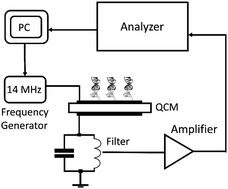A QCM-based rupture event scanning technique as a simple and reliable approach to study the kinetics of DNA duplex dissociation
Abstract
Rupture Event Scanning (REVS) is applied for the first time within an approach based on dynamic force spectroscopy. Using model DNA duplexes containing 20 pairs of oligonucleotides including those containing single mismatches, we demonstrated the possibility of reliable determination of the kinetic parameters of dissociation of biomolecular complexes: barrier positions, the rate constants of dissociation, and the lifetime of complexes. Within this approach, mechanical dissociation of DNA duplexes occurs according to a mechanism similar to unzipping. It is shown that this process takes place by overcoming a single energy barrier. In the case where a mismatch is located at the farthest duplex end from the QCM surface, a substantial decrease in the position of the barrier between the bound and unbound states is observed. We suppose that this is due to the formation of an initiation complex containing 3–4 pairs of bases, and this is sufficient for starting duplex unzipping.



 Please wait while we load your content...
Please wait while we load your content...